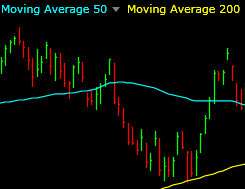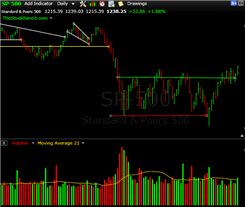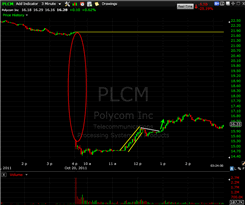 Archive for October, 2011
Archive for October, 2011
Video Review of the Indexes 10-30-2011
October 30, 2011 at 1:07 pm
The indexes ran higher last week, bolstered by a European debt deal which had been anticipated for quite a while now. With stocks rallying ahead of the news in recent weeks, the actual event actually prompted additional buying rather than a sell-the-news response. As a result, new recovery highs were established across the board.
As we head into a brand new week of trading, let’s examine some important levels to keep an eye on in the days ahead. That will have the greatest influence on how individual stocks are going to move, so it’s where the trading week begins.
Be sure to view in HD (720P) and full-screen mode for best quality in the video.
Trade Like a Bandit!
Jeff White
Producer of The Bandit Broadcast
Follow TheStockBandit on Twitter or get our free newsletter to keep up!
Market Makers, Specialists, and Stops
October 28, 2011 at 9:40 am
A subscriber recently asked me:
“Do you believe market makers and specialists really gun for the orders that are on the books that are only a few hundred shares, or do they only search out bigger size?”
Here’s my response:
 My take on market makers and specialists is that they just want volume, all day, as they’re selling on the offer and buying on the bid. A few hundred shares here throughout the day add up to a lot. Stocks will naturally gravitate toward key areas of support and resistance, so if they just get close then it’s not that difficult for market makers to ‘spook’ prices a little further and run some stops.
My take on market makers and specialists is that they just want volume, all day, as they’re selling on the offer and buying on the bid. A few hundred shares here throughout the day add up to a lot. Stocks will naturally gravitate toward key areas of support and resistance, so if they just get close then it’s not that difficult for market makers to ‘spook’ prices a little further and run some stops.
Suppose there’s resistance just a few cents away, they know buy stops reside beyond that level. Flashing a big bid will have shorts quickly covering based upon the quote (which is real by the way), and buyers step in front of it in hopes of catching a run. They can then flip that large order to the ask and it spooks everyone to sell, taking the stock right back down to where it was.
You can see how doing that throughout the day adds to the back-and-forth range-bound type of price action which churns the accounts of retail traders and leaves the stock not necessarily making any big headway.
Also, do not discount the presence of programs doing this exact same thing. If supercomputers can automate the process via algo’s, all the better for the smart money to spook the retail traders out of positions on a regular basis. Head-fake moves which last only long enough to inflict enough pain to prompt an exit is all it takes, so it need not be a lasting move to catch the small trader off guard and separate him from a dime here or a quarter there.
One last thing…
On a trend day when market makers are shorting into strength (selling on the offer during an uptrend ), if they didn’t have a lot of inventory to dump, then they’re getting shorter the higher we go. They will hedge via futures (ES or NQ) or through options. Those derivatives have a huge impact on how the market moves, yet few traders really recognize that.
So when people watch call buying activity or put buying activity in the options, they think they know that someone big is betting on a rise or fall in the shares, but the fact is nobody knows if it’s that simple or if it’s part of a more complicated hedge for a market-neutral position.
It gets cloudy, but there’s my take on market makers and specialists. What’s your opinion?
Trade Like a Bandit!
Jeff White
Producer of The Bandit Broadcast
Follow TheStockBandit on Twitter or get our free newsletter to keep up!
How to Think About a Loss
October 26, 2011 at 12:58 pm
 We all lose here and there, it’s just part of trading. You can’t avoid it, but that isn’t the issue. Where many traders struggle is how to handle a loss gracefully.
We all lose here and there, it’s just part of trading. You can’t avoid it, but that isn’t the issue. Where many traders struggle is how to handle a loss gracefully.
Instead if equating a trading loss with personal failure, shift your mentality for what a loss means.
Does it mean you’re stupid? Not necessarily.
Does it mean you were wrong? Yes, in at least one way.
Does that mean you will never get it back? Absolutely not.
Losses are an event, yes, but it’s also a distribution from your account. Consider them a cost of doing business as a trader. Brick-and-mortar stores have overhead, but as a trader, the biggest portion of your overhead is the losses you take.
When businesses cut costs, they’re reducing their overhead as much as possible to fatten their profit margins. Do the same with your trading. Reduce your ‘loss overhead’ by accepting a loss quickly and moving on to the next trade.
It’s much more fun to always be adding to your account rather than seeing funds flow out, but as soon as you start viewing trading losses as something impersonal, it’s going to change your perspective in a very helpful way. Rather than fret over them and allow losses to cloud your thinking or alter your mood, viewing them through the proper lens will help you more quickly get them back and then some.
Like it or not, trading is a business…how are you managing yours?
Trade Like a Bandit!
Jeff White
Producer of The Bandit Broadcast
Follow TheStockBandit on Twitter or get our free newsletter to keep up!
Questioning the 50-day & 200-day MA’s
October 25, 2011 at 6:50 am
 My recent post on Indicatoritis discussed how some traders rely on indicators incorrectly.
My recent post on Indicatoritis discussed how some traders rely on indicators incorrectly.
I believe that still holds true, but I was questioned about some common moving averages on the heels of that post.
So in this video, I want to discuss moving averages, and more specifically, two moving averages which are commonly accepted by traders as important: the 50-day and the 200-day moving averages.
We’ll look at some big-name stocks and let the charts speak for themselves on whether it’s appropriate or not to leave these MA’s on the chart all the time.
Be sure to view in HD (720P) and full-screen mode for best quality in the video.
Trade Like a Bandit!
Jeff White
Producer of The Bandit Broadcast
Follow TheStockBandit on Twitter or get our free newsletter to keep up!
Video Review of the Indexes 10-23-2011
October 23, 2011 at 10:17 am
 The indexes were able to put in some much-needed rest last week, holding their ground after their recent ramp. The S&P 500 marked a new recovery high (as did the DJIA), while the NAZ and RUT churned in their respective short-term bases.
The indexes were able to put in some much-needed rest last week, holding their ground after their recent ramp. The S&P 500 marked a new recovery high (as did the DJIA), while the NAZ and RUT churned in their respective short-term bases.
Technically, the picture has improved considerably, although it remains a headline-sensitive market right now with earnings season in full swing and all eyes on Europe.
As we head into a brand new week of trading, let’s examine some important levels to keep an eye on in the days ahead. That will have the greatest influence on how individual stocks are going to move, so it’s where the trading week begins.
Be sure to view in HD (720P) and full-screen mode for best quality in the video.
Trade Like a Bandit!
Jeff White
Producer of The Bandit Broadcast
Follow TheStockBandit on Twitter or get our free newsletter to keep up!
Post-Earnings Day Trading Profits
October 20, 2011 at 6:43 pm
 Earnings season brings with it a host of opportunities. It includes the potential for new leadership to emerge once it’s all said and done, but in the heat of it, the price action offers some excellent chances to participate in emotional short-term moves via day trades.
Earnings season brings with it a host of opportunities. It includes the potential for new leadership to emerge once it’s all said and done, but in the heat of it, the price action offers some excellent chances to participate in emotional short-term moves via day trades.
Traders expect big gaps during earnings season, and quite a few roll the dice ahead of it in hopes of receiving a market gift. Fortunately though, a trader need not participate in the gap itself to do well.
The post-earnings gap is a regular occurrence for most stocks, although some make a larger move than others. The outlier moves are the ones to watch closest, as they can signal either the beginning of a new move, or an overreaction with reversal potential.
Thursday’s move in PLCM was an example of the latter, as a 30% opening gap to the downside proved to be a bit much. The stock made a huge run higher intraday, although as I’ll show in the video, catching the entire run wasn’t necessary. Instead, grabbing pieces here and there can prove quite lucrative when there’s heavy volume and high emotion present.
In this video, I’ll share with you how I profited in the stock despite feeling like I missed both the big moves (the gap and most of the upside reversal). The fact is, when a stock is in play like PLCM was, there’s opportunity for several kinds of plays along the way. And the exciting part is that this happens nearly every day during earnings season, 4 times per year.
Be sure to watch full-screen on the 720p setting for the HD version of the video.
Trade Like a Bandit!
Jeff White
Producer of The Bandit Broadcast
Follow TheStockBandit on Twitter or get our free newsletter to keep up!
3 Ways to Overcome Your Fear from Past Trades
October 18, 2011 at 9:44 am
 Traders are a skittish bunch. We can make the same trade 100 times, but the one time a left-field event occurs, it can spook us forever.
Traders are a skittish bunch. We can make the same trade 100 times, but the one time a left-field event occurs, it can spook us forever.
The other night, I let the dog outside before bedtime. He’s a 7-year old Boston Terrier, so I’ve done that literally a couple thousand times. This time, however, he returned to the porch with an unusual look. I knew what happened before I even opened the door, because I could smell it…he’d been sprayed by a skunk.
An hour later after thoroughly bathing him outside, our house still reeked – despite not letting him in until he’d been bathed. And let me just say, fresh skunk spray smells nothing like roadkill skunk. It’s WAY worse.
Thankfully, the stench is long gone now, but that single event conditioned me, and I’m concerned now when I let him out every night…all because of that one awful experience! Doesn’t seem right, does it?
Spooked By The Past
In trading, we have to remind ourselves regularly to remain in the present tense. Because this setup burned you last time doesn’t mean it will this time. Maybe your first couple of trades of the day were losses, and now you’re scared to touch another trade. Or perhaps you’re coming off a tough few months and you’re afraid to get back in the mix.
While respect for the market and quality risk management are of utmost importance, what I’m referring to here is the crippling fear that’s costing you. It’s the fear that’s preventing you from elevating your performance, or from digging out of what should be a manageable hole. It’s the kind of fear that has you paralyzed and unable to pull the trigger on anything.
Return to Trading Confidently
Here are 3 Ways to Overcome Your Fear of the Past:
1. Understand your odds for success. This of course includes an honest risk assessment of the play, but it also means knowing whether this type of play is likely to work given the conditions. Going over your results consistently will reveal which kinds of plays are working in the current environment and which are more likely to fail. If you understand your odds for success and you’re able to have some mathematical confidence, it would be more costly to skip the trade.
2. Understand failure. Knowing the worst-case outcome if this trade happens to fail can reduce the fear inflicted by a previous failure from an unseen event. Black swan events aren’t common, so it’s not reasonable to fear them every time you approach a setup. Weigh the potential for loss, and if it’s outweighed by the potential for gain, the probabilities are favorable enough to participate.
3. Choose to move forward. All of us have the ability to choose, whether it’s our career or our spouse or our attitude. Maybe your fear somehow gives you comfort right now, because it’s been a habit you’ve allowed. That won’t cut it though, so it’s time to change. Eventually, you either decide to get back on the right path, or you’re completely done trading. Make your choice and get on with it – and don’t look back.
Don’t let the past haunt you into skipping potentially solid plays. Assess your risk, and then take the trade confident that over time, the numbers will work to your advantage.
Trade Like a Bandit!
Jeff White
Producer of The Bandit Broadcast
Follow TheStockBandit on Twitter or get our free newsletter to keep up!





